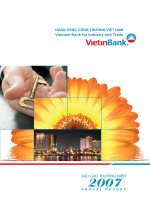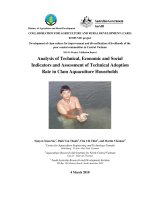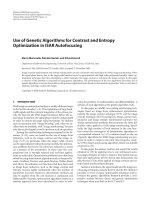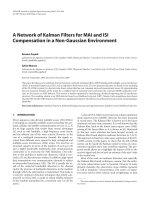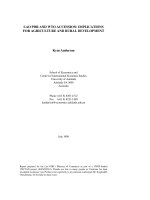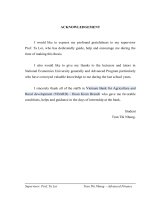FACTORS AFFECTING COMPETITIVENESS OF VIETNAM BANK FOR AGRICULTURE AND RURAL DEVELOPMENT IN BA RIA - VUNG TAU PROVINCE
Bạn đang xem bản rút gọn của tài liệu. Xem và tải ngay bản đầy đủ của tài liệu tại đây (711.51 KB, 14 trang )
<span class='text_page_counter'>(1)</span><div class='page_container' data-page=1>
<b>FACTORS AFFECTING COMPETITIVENESS OF VIETNAM BANK FOR </b>
<b>AGRICULTURE AND RURAL DEVELOPMENT IN BA RIA - VUNG TAU </b>
<b>PROVINCE </b>
PHAM XUAN GIANG, NGUYEN NGUYEN PHUONG
Industrial University of Ho Chi Minh City
,
<b>Abstract. Enterprises’competitiveness determines the performance of businesses in general and banks in </b>
particular. Therefore, among internal and external factors impacting on businesses, internal factors play
decisive roles. As the survey responded by 200 bank staffs of Vietnam Bank for Agriculture and Rural
Development in Ba Ria- Vung Tau province (Agribank Ba Ria- Vung Tau) on October 2018 then
analyzed via SPSS 20, there’re 05 internal factors affecting its competitiveness: marketing capability,
technologcial capability, brand, service quality and professional compentence. Accordingly, 5
implications are suggested based on the research results in order to increase the competitiveness of
Agribank Ba Ria-Vung Tau.
<b>Keywords. competitiveness, Agribank Ba Ria-Vung Tau, Cronbach’Alpha, EFA, Multivariate </b>
Regression, implications
<b>1 </b>
<b>INTRODUCTION </b>
Located in the South East region of Vietnam, Ba Ria-Vung Tau is a famous tourist destination which
annually welcomes hundreds of thousands of domestic and foreign tourists. Furthermore, Ba Ria-Vung
Tau is also the headquarters of many large companies, including Vietsovpetro joint venture. Hence, the
demand for opening account, withdrawing, transfering and exchanging money is quite enormous.
Agribank Ba Ria-Vung Tau directly under Vietnam Bank for Agriculture and Rural Development is
located at 21 Nguyen Huu Tho, Phuoc Trung Ward, Ba Ria City, Ba Ria - Vung Tau Province with 29
branches and transaction offices located in 7 out of 8 administrative units of the province, and more than
340 employees. Especially, Agribank Con Dao is under management of Agribank Ho Chi Minh City.
There are almost major domestic and international commercial banks in BRVT, which fiercely
compete with others for market share. As Vietnam has entered into more and more Free Trade
Agreements, the competition becomes more intensive. Thus, to be the winner in the market, our domestic
commercial banks in general, Agribank Ba Ria-Vung Tau in particular should build a strong brand,
improve service quality and professional competence, technology, financial capability, management
capability and marketing capability to promote all power to improve competitiveness to increase business
efficiency. Therefore, the research was conducted with the following objectives: examining summarily
theories and models related to enterprises’ competitiveness; designing research model and hypotheses on
competitiveness; quantitative analyzing and testing the impact of factors affecting competitiveness of
Agribank BRVT and recomending implications.
<b>2 </b>
<b>LITERATURE REVIEW </b>
Competition is a complex socio-economic phenomenon and an indispensable rule of market
economy. It also creates a driving force for economic development. Hence, companies, especially banks
considered competition as inevitable situation that they must accept. As M. Porter [1], competition is
gaining market share. The nature of competition is to seek for profit, which is a higher profit than the
enterprise’s current average profit. The consequence of the competition process is averaging out the
profits of the industry in the direction of deep improvement, leading to the reduction in prices.
</div>
<span class='text_page_counter'>(2)</span><div class='page_container' data-page=2>
According to M.Porter [1], the enterprises’ competitiveness is the ability to exploit and make use of
their unique and special advantages to firmly gain the foothold against competitive pressures. As Nguyen
Thanh Phong [2], “Competitiveness is the ability created by the bank on the basis of maintaining and
developing inherent advantages, in order to consolidate and expand market share; increase profits and be
able to resist and overcome adverse fluctuations of the business environment”.
With the same conclusion, Nguyen Thi Quy [3] indicated that the competitiveness of a bank is the
ability to create, maintain and develop its advantages to maintain and expand market share; achieve
higher profitability than the average one of the industry, and continuously increase, while ensuring safe
and healthy operation, being able to resist and overcome adverse fluctuations of the business
environment”.
Regarding to internal factors, Sanchez & Heene [4] determined that the enterprises’ competitiveness
is the ability to combine resources to create competitive advantages. There have been many research
theories on the businesses’ competitiveness which were adopted in this research, including Five Forces
Model of M.Porter [1], VRIN-Barney competition theory [5] and Thompson-Strickland [6] method.
Accordingly, M.Porter pintpointed 5 competitive pressures of enterprises. Meanwhile Barney helped in
determining whether resources are a sustainable competitive advantage of the business or not. As
Thompson-Strickland, from perspective of endogenous factors, 13 internal factors were indicated that
affected competitiveness. However, since these are general and theoretical models, the model used for
competitiveness of banks should be specific to make it appropriate to the characteristics of the industry in
Vietnam.
<b>Research model and hypotheses </b>
A lot of researches were conducted on the enterprises’s competitiveness, especially banks, named as
<b>studies of Nguyen Van Thuy [7], Huynh Thi Phi Duyen [8], Nguyen Thanh Phong [2], Nguyen Dinh Tho </b>
& Nguyen Thi Mai Trang [9], Nguyen Thi Quy [3] in Vietnam; and studies of John Tatom [10],
<b>Aboagye-Debrah [11], Thomspon-Strickland [6] worldwide. As refering above mentioned models and </b>
qualitative research result, the authors defined 7 independent scales affecting dependent factor, the
competitiveness of Agribank Ba Ria-Vung Tau.
<i>Brand: There is a strong relationship between brand and competitiveness. A strong brand will </i>
strengthen customers’ belief in the safety, convenience, professionalism, reasonable price, etc., leading to
the increase of amount of customers, market share, and competitiveness as well. This relationship was
proved in the research of Thomspon-Strickland [6], Huỳnh Thị Phi Duyen [8], etc.
<i>Service quality: Good service quality will create competitive advantages, improving </i>
enterprises’ competitiveness. The bank service quality is reflected via the attitude and capability of
serving, prromptness and empathy, service prices and modern facilities. Considering the relationship
between competitiveness and service quality, it was identified in the study of Zeithaml & Leonard
L.Berry [12].
<i>Professional competence: As previous researches of Porter [1], Wu and Cavusgil [13], </i>
employees’ professional competence is reflected in their qualifications, experience and ability to perform
specialized operations. This factor has a strong impact on rganizations’ competitiveness in general and
commercial banks’ one in particular.
<i>Management capability: According to Michael E. Porter [1], management capability is the </i>
vital factor determining the existence, development and competitiveness of an enterprise. This factor is
reflected in professional qualifications; management staff’s capability of organizing, managing, planning
adapting to changes of business environment. The relationship between management capability and
enterprise’s competitiveness was priviously identified in many researches named as Michael E. Porter [1],
Nguyen Dinh Tho & Nguyen Thi Mai Trang [6].
</div>
<span class='text_page_counter'>(3)</span><div class='page_container' data-page=3>
<i>Marketing capability: Marketing capabicity helps businesses implement marketing programs </i>
effectively, capture changes in customers’ needs in order to provide more new and more suitable products
and services. Hence, marketing capacity was proved to have a positive impact on businesses’
competitiveness. The relationship between marketing capability and enterprises’ competitiveness has
been studied by Homburg et al., [16], Porter [1]; Nguyen Dinh Tho and Nguyen Thi Mai Trang [9].
<i>Technological capability: Bank’s products and services with application of modern </i>
technology such as: collecting payment for electricity via Internet/ Mobile Banking / POS, paying train
tickets, air tickets through the online payment system or bank card, collecting tuition fees, hospital fees
through electronic banking channels, transfering money through mobile banks, etc. at all times and
everywhere, which increase the competitiveness of businesses in general and banks in particular.
Thompson Strickland [6], Nguyen Thanh Phong [2], Huynh Thi Phi Duyen [8] had conducted researches
to determine this issue.
As above definitions, the proposed research model are determined with 7 independent scales and 1
dependent scale as following
Brand
Financial capability
Management
capability
Service quality
Professional
competence
Competitiveness of
Agribank Ba Ria-Vung Tau
Marketing capability
Technological capability
</div>
<span class='text_page_counter'>(4)</span><div class='page_container' data-page=4>
<i>Research’s hypothese are as following: </i>
Hypothesis H1: Brand has a positive effect on the competitiveness of Agribank Ba Ria-Vung Tau.
Hypothesis H2: Service quality has a positive effect on the competitiveness of Agribank Ba
Ria-Vung Tau.
Hypothesis H3: Professional competence (of staff) has a positive effect on the competitiveness of
Agribank Ba Ria-Vung Tau.
Hypothesis H4: Management capability has a positive effect on the competitiveness of Agribank Ba
Ria-Vung Tau.
Hypothesis H5: Financial capability has a positive effect on the competitiveness of Agribank Ba
Ria-Vung Tau.
Hypothesis H6: Marketing capability has a positive effect on the competitiveness of Agribank Ba
Ria-Vung Tau.
Hypothesis H7: Technological capability has a positive effect on the competitiveness of Agribank Ba
Ria-Vung Tau.
There’re 38 variables of the measurement scale in the official proposed research model shown in the
<b>table below: </b>
<i>Table 2.1. Codes of scales and variables of research model </i>
<b>Code </b> <b>Variables </b>
<b>BRAND </b>
<b>(TH) </b>
<b>1 </b> TH1 Agribank Ba Ria-Vung Tau is prestigious and reliable.
<b>2 </b> TH2 Agribank Ba Ria-Vung Tau is trusted by customers.
<b>3 </b> TH3 Agribank Ba Ria-Vung Tau is well-known.
<b>4 </b> TH4 Agribank Ba Ria-Vung Tau highly satisfy its customers.
<b>5 </b> TH5 Agribank Ba Ria-Vung Tau responds quickly to customers’ changes.
<b>SERVICE </b>
<b>QUALITY </b>
<b>(CLDV) </b>
<b>6 </b> CLDV1 Agribank Ba Ria-Vung Tau staff’s attitude is good and service-oriented.
<b>7 </b> CLDV2 Agribank Ba Ria-Vung Tau’s staff quickly process customers’ requests.
<b>8 </b> CLDV3 Agribank Ba Ria-Vung Tau’s services timely meet the customers’ needs.
<b>9 </b> CLDV4 The procedure of Agribank Ba Ria-Vung Tau is simple.
<b>10 </b> CLDV5 The price of banking services is highly competitive
<b></b>
<b>PROFESS-IONAL </b>
<b>COMPETE</b>
<b>NCE </b>
<b>(NLCM) </b>
<b>11 </b> NLCM1 Staffs are professional and skillful.
<b>12 </b> NLCM2 Staff’s qualifications are appropriate with their positions.
<b>13 </b> NLCM3 Staff are always trained to improve their skills and professional knowledge.
<b>14 </b> NLCM4 Staff can speak to customers in English.
<b></b>
<b>MANAGE-MENT </b>
<b></b>
<b>CAPABIL-ITY </b>
<b>(NLQT) </b>
<b>15 </b> NLQT1 Agribank Ba Ria-Vung Tau’s managenemt board performs highly efficiently.
<b>16 </b> NLQT2 Agribank Ba Ria-Vung Tau has good business strategy and plans.
<b>17 </b> NLQT3 Agribank Ba Ria-Vung Tau’s human resources are well-organized.
<b>18 </b> NLQT4 Agribank Ba Ria-Vung Tau mantains the balance of funds and budgets.
<b>19 </b> NLQT5 Agribank Ba Ria-Vung Tau is able to analyze the market to propose good
business strategy.
<b>FIANCIAL </b>
<b></b>
<b>CAPABIL-ITY </b>
<b>(NLTC) </b>
<b>20 </b> NLTC1 Agribank Ba Ria-Vung Tau has suitable financial structure.
<b>21 </b> NLTC2 Agribank Ba Ria-Vung Tau is capable of raising funds.
<b>22 </b> NLTC3 Agribank Ba Ria-Vung Tau has high liquidity.
<b>23 </b> NLTC4 Agribank Ba Ria-Vung Tau can make profit from its capital.
<b>24 </b> NLTC5 Agribank Ba Ria-Vung Tau’s bad debt is low.
<b></b>
<b>MARKETI-NG </b>
<b></b>
<b>CAPABIL-ITY </b>
<b>(NLM) </b>
<b>25 </b> NLM1 Agribank Ba Ria-Vung Tau always communicates with customers to understand
customers’ needs.
<b>26 </b> NLM2 Agribank Ba Ria-Vung Tau builds up good relationships with customers.
<b>27 </b> NLM3 Agribank Ba Ria-Vung Tau usually applies market researches to collect data on
customers’ needs.
<b>28 </b> NLM4 Agribank Ba Ria-Vung Tau organizes many attractive promotions.
<b>29 </b> NLM5 Agribank Ba Ria-Vung Tau carries out many programs for community.
</div>
<span class='text_page_counter'>(5)</span><div class='page_container' data-page=5>
<b>TECHNOL</b>
<b>-OGICAL </b>
<b></b>
<b>CAPABIL-ITY </b>
<b>(NLCN) </b>
<b>31 </b> NLCN1 Agribank Ba Ria-Vung Tau has good facillities and technology.
<b>32 </b> NLCN2 Agribank Ba Ria-Vung Tau always updates and applies information technology
advance in card services.
<b>33 </b> NLCN3 Agribank Ba Ria-Vung Tau provides customers with many utilities in
transferring Atransfer, Vnmart e-wallet, etc.
<b>34 </b> NLCN4 Agribank Ba Ria-Vung Tau has always expands its business scale by establishing
new transaction counters and ATM stations to serve its customers.
<b>COMPETI</b>
<b>TIVENESS </b>
<b>(NLCT) </b>
<b>35 </b> NLCT1 Agribank Ba Ria-Vung Tau’s has strong competitiveness compared with its rivals.
<b>36 </b> NLCT2 Agribank Ba Ria-Vung Tau will continue to develop in the long-term
<b>37 </b> NLCT3 Agribank Ba Ria-Vung Tau achieves stable growth and sustainable market
development.
<b>38 </b> NLCT4 Agribank Ba Ria-Vung Tau has a good position and image in the market.
<b> </b>
<i>Source: synthesized from documents and experts’ opinions</i><b>3 </b>
<b>RESEARCH METHODOLOGY </b>
Two research methods are applied in this study:
<i>Qualitative research method </i>
Direct discussion technique was adopted with 5 chiefs, deputy directors of branches and transaction
offices of Agribank Ba Ria-Vung Tau based on a designed outline to explore, adjust and supplement
measurement scale and variables.
<i>Quantitative research method: Includes 2 stages: </i>
(1) Pilot research: The data used in this study were collected from 50 staffs with convenient sampling
method, then tested Cronbach’s Alpha and EFA to preliminarily evaluate scales and variables. Besides,
pilot research is applied to adjust words and content to make the questionnaire easy to understand by
omitting misunderstanding or heterogeneity of understanding among participants. Cronbach’s Alpha Test
is applied for the purpose of removing inappropriate scales and variables. The inspection standards was
determined (1) the scales are excluded from the research model if Cronbach’s Alpha coefficient is less
than 0.6; (2) The variables are removed from the scale if the Corrected Item-Total Correlation is less than
0.3.
(2) Official quantitative research: SPSS 20 was used to analyze the data collected from 200 bank
staff to identify the factors really affecting competitiveness and their impact level as well. Thence, the
implications were suggested to improve the competititveness of Agribank Ba Ria-Vung Tau.
<i>Sample size and structure </i>
As Hoang Trong & Chu Nguyen Mong Ngoc [17] recommended that the sample size could be minimum
of 100 with the ratio of 5:1 (which means each variables of independent scale requires for 5 participants).
Thus, with 34 variables of 7 independent scales, the minimum sample size is 170 (=34*5). However, to
increase the accuracy and anticipation of invalid answers, the sample size was determined of 215
Agribank BRVT’s staffs with the non-probability and convenience sampling method.
There’re 200 valid answered questionnaires collected over 215 distributed ones, accounting for 93%.
As gender structure, female accounted for 73%, and male of 27%. As age structure: those under 35
accounted for 62% and the left of 38% is accounted by those over 35. For working seniority, categories of
under 1 year, from 1 to 3 years, and more than 3 years respectively accounted for 10%, 13% and 77%.
<b>4 </b>
<b>RESEARCH FINDINGS, DISCUSSION AND IMPLICATIONS </b>
<b>4.1 Testing Cronbach’s Alpha of independent scale </b>
Five independent scales are applied Cronbach’s Alpha test for one time. Two left scales need to be
tested Cronbach’s Alpha for the second time. Details’re as following:
</div>
<span class='text_page_counter'>(6)</span><div class='page_container' data-page=6>
For the first time of testing, “Professional competence-NLCM” scale received the Cronbach’s Alpha
<i>of 0.713 which is greater than 0.6; however, the Corrected Item-Total Correlation of the variable “Staff </i>
<i>can speak to customers in English.-NLCM4” received the value of 0.169 which is less than 0.3. Hence, </i>
this variable is removed from the scale. For the second time of testing, the Professional competence scale
with its variables is acepted. The last results of testing Cronbach’s Alpha of 7 independent scales are as
following:
<i>Table 4.1: Results of Testing Cronbach’s Alpha of independent scale</i>
<b>Scale </b> <b>Variable </b> <b>Corrected Item-Total </b>
<b>Correlation </b>
<b>Cronbach's Alpha if </b>
<b>Item Deleted </b>
Brand (TH)
<b>Cronbach’s Alpha =.877 </b>
TH1 .604 .875
TH2 .710 .851
TH3 .744 .843
TH4 .683 .857
TH5 .804 .828
Service quality
<b>(CLDV) </b>
<b>Cronbach’s Alpha = .895 </b>
CLDV1 .713 .879
CLDV2 .821 .855
CLDV3 .776 .866
CLDV4 .579 .910
CLDV5 .845 .849
<b>Professional competence </b>
<b>(NLCM) </b>
<b>Cronbach’s Alpha =.852 </b>
NLCM1 .657 .855
NLCM2 .802 .718
NLCM3 .713 .802
<b>Management capability </b>
<b>(NLQL) </b>
<b>Cronbach’s Alpha =.828 </b>
NLQT1 .638 .791
NLQT2 .737 .746
NLQT3 .614 .804
NLQT4 .637 .792
<b>Financial capability </b>
<b>(NLTC) </b>
<b>Cronbach’s Alpha =.796 </b>
NLTC1 .621 .743
NLTC2 .674 .724
NLTC3 .586 .754
NLTC4 .357 .820
NLTC5 .656 .731
<b>Marketing capability </b>
<b>(NLM) </b>
<b>Cronbach’s Alpha =.944 </b>
NLM1 .736 .945
NLM2 .825 .935
NLM3 .889 .927
NLM4 .834 .934
NLM5 .841 .933
NLM6 .865 .930
<b>Technological capability </b>
<b>(NLCN) </b>
<b>Cronbach’s Alpha =.877 </b>
NLCN1 .663 .876
NLCN2 .834 .803
NLCN3 .750 .839
NLCN4 .713 .851
<i>Source: Authors’ analysis </i>
<b>4.2 Testing Cronbach’s Alpha of dependent scale </b>
</div>
<span class='text_page_counter'>(7)</span><div class='page_container' data-page=7>
<i>Table 4.2. Results of Testing Cronbach’s Alpha of dependent scale </i>
<b>Scale </b> <b>Variable </b> <b>Corrected Item-Total </b>
<b>Correlation </b> <b>Cronbach's Alpha if </b>
<b>Item Deleted </b>
Competitiveness (NLCT)
<b>Cronbach’s Alpha =.912 </b>
NLCT1 .823 .878
NLCT2 .786 .891
NLCT3 .805 .884
NLCT4 .790 .891
<i>Source. Authors’ analysis </i>
<b>In summary, after applying Cronbach’s Alpha test, there are 32 (over 34) variables of 7 </b>
independent scales left (NLQT5 and NLCM 4 are removed); there is no adjustment of the dependent
scales with 4 variables. 8 scales with 36 variables are qualified to be analyzed in the next stage.
<b>4.3 Exploratory Factor Analysis (EFA) </b>
The purpose of Exploratory Factor Analysis is to remove variables with factor loading of less than
0.5, and variables not belonging to any factor.
<i>Exploratory Factor Analysis of independent scale: As the result of the first EFA analysis, the </i>
variable of “Agribank BRVT can make profits from its capital- NCL4” is eliminated as its factor loading
shows the relation to other factors. The left variables loaded onto the subscale “Financial capability-
NLTC”. The EFA was conducted for the second time, and the results are as follows:
<i>Table 4.3. KMO and Bartlett's Test </i>
Kaiser-Meyer-Olkin Measure of Sampling Adequacy. .793
Bartlett's Test of Sphericity
Approx. Chi-Square 4521.678
df <sub>465 </sub>
Sig. <sub>.000 </sub>
<i>Source: Authors’ analysis </i>
KMO = 0.793 which is greater than 0.5 indicates the suitability of EFA and practical data.
Bartlett test result with sig = 0.000 which is less than 0.05 demonstrates that the variables are
correlated as a whole.
Eigenvalue= 1,219 >1 of the Principal Components method, 7 factors are extracted from 31
variables.
Average Variance Extracted= 72,462% >50%, which demonstrates that 72,462% Variation of
data could be explained by 07 factors as presented in two following tables:
<i>Table 4.4. Total Variance Explained </i>
Component
Initial Eigenvalues
Extraction Sums of Squared
Loadings
Rotation Sums of Squared
Loadings
Total
% of
Variance
Cumulative
% Total
% of
Variance
Cumulative
% Total
% of
Variance
Cumulative
%
1 8.262 26.651 26.651 8.262 26.651 26.651 4.799 15.479 15.479
2 3.782 12.201 38.852 3.782 12.201 38.852 3.605 11.631 27.110
3 2.748 8.865 47.718 2.748 8.865 47.718 3.473 11.202 38.312
4 2.644 8.529 56.246 2.644 8.529 56.246 3.024 9.754 48.066
5 2.268 7.317 63.563 2.268 7.317 63.563 2.696 8.696 56.762
6 1.539 4.966 68.529 1.539 4.966 68.529 2.566 8.278 65.040
7 1.219 3.933 72.462 1.219 3.933 72.462 2.301 7.422 72.462
8 .996 3.213 75.675
</div>
<span class='text_page_counter'>(8)</span><div class='page_container' data-page=8>
<i>Table 4.5. Rotated Component Matrix</i>a
Component
1 2 3 4 5 6 7
NLM6 .877
NLM3 .864
NLM5 .847
NLM4 .829
NLM2 .821
NLM1 .818
CLDV5 .865
CLDV3 .835
CLDV2 .830
CLDV1 .741
CLDV4 .692
TH5 .860
TH2 .815
TH3 .810
TH4 .758
TH1 .715
NLCN2 .900
NLCN3 .840
NLCN4 .817
NLCN1 .805
NLQT2 .870
NLQT1 .804
NLQT3 .789
NLQT4 .778
NLTC1 .808
NLTC5 .737
NLTC2 .725
NLTC3 .655
NLCM2 .880
NLCM3 .827
NLCM1 .739
</div>
<span class='text_page_counter'>(9)</span><div class='page_container' data-page=9>
<i>Exploratory Factor Analysis of dependent scale: This analysis was conducted as the same way </i>
for independent scale. After one time of analysis, the result is shown as below:
KMO is .839 which is greater than 0.5; Bartlett test received the sig of 0.000 which is less than
0.05.
At Eigenvalue 3.171 >1 of the Principal Components method Principal Components, 1 factor is
extracted from 4 variables.
Average Variance Extracted= 79.278% >50%, which demonstrates that 79.278% variation of data
could be explained by 1 factors.
In summary, after conducting Exploratory Factor Analysis, 7 independent scales with 32 variables
are extracted into 7 factors with 31 variables. There’s 1 variable rejected. 1 dependent scale is extracted
from 4 variables. The adjusted research model is as following:
<b> </b>
<i>Figure 4.1. The adjusted research model </i>
<b>4.4 Multiple regression analysis </b>
For the first time of testing, “Financial capability-NLTC” factor is rejected because of the Sig is.848
which is greater than .05; for the second time of testing, “Management capability-NLQT” is rejected
because the Sig is .388 which is greater than .05. The left 5 factors were used to analyze for the third time.
The result is as following:
<i>Table 4.6: Model Summary </i>
Marketing
capability
Management
capability
Technological
capability
Service quality
Brand
Competitiveness of
Agribank BRVT
Financial capability
</div>
<span class='text_page_counter'>(10)</span><div class='page_container' data-page=10>
Model R
R
Square
Adjusted
R Square
Std. Error
of the
Estimate
Change Statistics
Durbin-Watson
R Square
Change
F
Change df1 df2
Sig. F
Change
1 .717a .515 .502 .4798531 .515 41.149 5 194 .000 2.275
As table 4.6, it shows the high apprropriacy of the model with R=.717, R2 = .515 and Adjusted R2
= .502, which demonstrates that 50.2% of competitiveness can be explained by 7 independent factors.
<i>Table 4.7: ANOVA </i>
Model Sum of Squares df Mean Square F Sig.
1 Regression 47.375 5 9.475 41.149 .000b
Residual 44.670 194 .230
Total 92.045 199
<i>Source. Author’s analysis </i>
As above table, F=41.149 and Sig = 0.000 <0.05, which demonstrate that the model is consistent
with reality, and independent factors were proved to have a linear correlation with the dependent factor.
<i>Table 4.8. Coefficients </i>
Model
Unstandardized
Coefficients
Standardized
Coefficients
t Sig.
95.0% Confidence
Interval for B
Collinearity
Statistics
B
Std.
Error Beta
Lower
Bound
Upper
Bound Tolerance VIF
1 (Constant) -.034 .264 -.130 .897 -.556 .487
NLM .414 .052 .444 7.996 .000 .312 .516 .810 1.234
CLDV .148 .069 .133 2.155 .032 .013 .283 .660 1.515
TH .180 .058 .169 3.097 .002 .065 .294 .836 1.196
NLCN .210 .052 .219 4.069 .000 .108 .313 .864 1.158
NLCM .118 .058 .121 2.051 .042 .005 .232 .721 1.386
<i> Source:Author’s analysis </i>
After multiple regression analysis, there are 2 factors rejected. The remaining 5 factors receive
the Sig values of less than 0.05 and are positively correlated with the dependent factor
“Competitiveness-NLCT”. This indicates that there are 5 factors really affecting the competitiveness of Agribank Ba
Ria-Vung Tau.
The regression equation with standardized coefficients is presented as below:
<b>NLCT= 0,444*NLM + 0,219*NLCN + 0,169*TH + 0,133*CLDV + 0,121*NLCM </b>
<i><b>As the regression result, Marketing capability-NLM (</b></i>=0.444) has the strongest effect on
<i><b>competitiveness; Technological capability-NLCN (</b></i>=0.219) has the second strongest effect on
<i><b>competitiveness; Brand-TH (</b></i><i><b>=0.169) and Service quality-CLDV (</b></i>=0.133) were ranked respectively
third and fourth position. The factor with least effect on competitiveness of Agribank Ba Ria- Vung Tau
<i><b>was Professional competence (</b></i>=0.121).
</div>
<span class='text_page_counter'>(11)</span><div class='page_container' data-page=11>
<i>Table 4.9. The Absolute influence and Relative influence of independent factors on dependent factor </i>
Factor
NLM
NLCN
TH
CLDV
NLCM
Total impact
Absolute influence
0.444
0.219
0.169
0.133
0.121
1.086
Relative influence (%)
40.88
20.17
15.56
12.25
11.14
100.00
<i>Source: Author’s analysis </i>
<b>4.5 Verified hypotheses </b>
Regression results determine that 5 hypotheses of the research model are accepted.
Hypotheses Results
H1 Accepted
H2 Accepted
H3 Accepted
H6 Accepted
H7 Accepted
<b>4.6 Testing multicollinearity </b>
As presented in Table 4.8, five independent factors received the VIF<10 (from 1.158 to 1.515),
which indicates that there’s no multicollinearity in the regression model.
<b>4.7 Testing Durbin – Wastion </b>
As shown in table 4.6, d value in Durbin-Wastion is 2.275, which satisfies the condition of 0
<2.275<3. Hence, it could be infered that there’s no autocorrelation of residuals in the research model.
<b>4.8 Implications </b>
<i> Improving marketing capability of Agribank Ba Ria-Vung Tau </i>
Regular communication with customers is the best way to better understand customers’ needs to be
able to serve them better and make them more satisfied. Hence, the bank will not only retain its traditional
customers, but also make them involve in word of mouth marketing and engage new customers.
Establishing good relationships with all levels of local authorities, courts, People's Procuracy, auction
centers, etc. is also essential for Agribank Ba Ria-Vung Tau. Thanks to these relationships, the bank will
be supported by the local authorities as well as other organizations to help people quickly complete
administrative procedures and necessary documents of borrowing money from Agribank Ba Ria- Vung
Tau. To enhance Agribank Ba Ria-Vung Tau’s marketing capability, community programs, attractive
promotions, new and unique product launch should be carried out and introduced to engage more
customers with the simultaneous combination of improving competence of marketing department. This
should be considered as the duties and rights of each staff of every departments, not only bank’s
marketing department.
<i>Improving technological capability of Agribank Ba Ria-Vung Tau </i>
</div>
<span class='text_page_counter'>(12)</span><div class='page_container' data-page=12>
upgrade the old ATM stations, ensure security and safety for customers when conducting transactions in
these stations.
<i>Developing brand of Agribank Ba Ria- Vung Tau </i>
Agribank Vietnam is a strong and reputable brand among commercial banks in our country,
which has made major contributions to the development of the economy. However, Agribank Vietnam
has recently caused some scandals affecting the whole system. Therefore, in order to strengthen the brand
in the locality, Agribank Ba Ria-Vung Tau should come up with solutions of brand development to
increase the brand awareness, recall and to orient customers to find and use the service. Therefore,
Agribank Ba Ria-Vung Tau should widely promote their image via mass media, create and enhance its
position through the daily staff’s interaction with customers to help them gain and adapt flexibly to
customers’ changes. Thence, it can gradually earn the trust, and reliability in the locals and visitors’
minds. A healthy and professional workplace culture environment shoud be fostered. All staff should
have the service minds with the slogan “Everything is for customers”.
<i>Improve services quality </i>
Service quality was ranked as the fourth strong factor affecting the competitiveness of Agribank
Ba Ria-Vung Tau. In order to enhance the services quality, bank staff should take a better attitude to
customers with enthusiastic serving manner, and quickly implement customers’ requirements to help
customers create absolute trust in Agribank Ba Ria-Vung Tau. Otherwise, it will be difficult to raise
deposits as well as perform other business activities. More seriously, customers will leave for another
more trustworthy bank. The deposition procedure is simple, but not for the withdrawal due to the
requirement of signing exactly the original signature signed for the previous deposits which discourages
the elderly. As they get older and after a little time of signing, these reasons prevent this group of
customers can't sign exactly their original signatures. Therefore, in addition to the signature, Agribank Ba
Ria-Vung Tau needs to have other ways of checking to determine correctly the deposit’s owner. Besides,
transaction office should allocate staff to instruct to fill in the required forms. Simple banking procedures
with more competitive services price will be a key to success of Agribank Ba Ria-Vung Tau.
<i>Improve staff’s professinal competence </i>
</div>
<span class='text_page_counter'>(13)</span><div class='page_container' data-page=13>
<b>5 CONCLUSION </b>
The research pinpointed model of 05 factors affecting competitiveness of Agribank Ba Ria- Vung
Tau, and also determined the impact level of each factor. There are two limitations of this study. Firstly,
as the research’s data were collected through non-probability sampling technique and convenience
method, the representativeness of the sample is not so high. Secondly, the enterprise’s competitiveness
based on both internal and external factors. They even sometimes resonated to determine the
competitiveness of a business. This can be a shortcoming of this study to consider only internal factors of
the bank. For the future research directions, sampling method of probability or ratio method of surveyed
staff over totall staff of each branch or transaction office should be adopted with larger sample size. Both
internal and external factors affecting competitiveness of Agribank BRVT should be considered in the
next study.
<b>REFERENCES </b>
<i>[1] Porter, M., Competitive Advantage, New York: Free Express, 1985. </i>
<i>[2] Nguyễn Thanh Phong, Năng lực cạnh tranh của các Ngân hàng Thương mại Việt Nam sau khi Việt Nam gia nhập WTO, </i>
<i>Thực trạng và giải pháp. Luận văn thạc sĩ, trường Đại học Kinh tế TP.HCM, 2010. </i>
<i>[3] Nguyễn Thị Quy. Năng lực cạnh tranh của các ngân hàng thương mại trong xu thế hội nhập. NXB Lý luận </i>
chính trị, 2008.
<i>[4] Sanchez, R. and Heene, A., The new strategic management - Organization, competition, and competence. New </i>
York: Wiley, 2004.
[5].<i>Barney J., Firm Resources and Sustained Competitive Advantage. Journal of Management, (1991). </i>
<i>[6] Arthur A. Thompson, Jr., A. J. Strickland, Strategic Management Concepts and Cases, University of Alabama, </i>
1998.
<i>[7] Nguyễn Văn Thụy, Ảnh hưởng của nhân tố năng lực cạnh tranh đến kết quả hoạt động kinh doanh của các Ngân </i>
<i>hàng TMCP trên địa bàn TP.HCM. Luận văn tiến sĩ, Trường Đại Học Kinh tế Thành phố Hồ Chí Minh, 2015. </i>
<i>[8] Huỳnh Thị Phi Duyên, Nâng cao năng lực cạnh tranh của NHNN&PTNT chi nhánh Quảng Ngãi. Luận văn thạc </i>
sĩ, Đại học Tài chính Marketing, 2015.
<i>[9] Nguyễn Đình Thọ & Nguyễn Thị Mai Trang, Năng lực cạnh tranh động của doanh nghiệp Việt Nam trong Nghiên </i>
<i>cứu khoa học trong Quản trị kinh doanh. NXB Thống Kê, tr.187- 183, 2009. </i>
<i>[10] John Tatom, Predicting failure in the commercial banking industry. Networks Financial Institute at Indiana </i>
State University, Working Pape, 2008.
<i>[11] Aboagye - Debrah, K., Competition, Growth and Performance in the banking industy in Chana. Unpublished </i>
Doctor of Philosophy, St Clements Universisty, 2007.
[12] Parasuraman A, Zeithaml VA & Berry LL., A conceptual model of
<i>service quality and its implications for future research. Journal of Marketing, 49, 41- 50, 1985. </i>
[13] Wu F & Cavusgil T., Organizational learning, commitment, and joint value creation in interfirm relationships.
<i>Journal of Business Research, 59(1), 81 – 89, 2006. </i>
</div>
<span class='text_page_counter'>(14)</span><div class='page_container' data-page=14>
<i>[15] Aboagye - Debrah, K., Competition, Growth and Performance in the banking industy in Chana. Unpublished </i>
Doctor of Philosophy, St Clements Universisty, 2007.
[16] Homburg et al., Responsiveness to costomers and competitors: The role of affective and cognitive
<i>organizational systems. Journal of Marketing, 71, 18 – 38, 2007. </i>
<i>[17] Hồng Trọng, Chu Nguyễn Mộng Ngọc, Phân tích dữ liệu nghiên cứu với SPSS. Hồng Đức, 2008. </i>
</div>
<!--links-->



